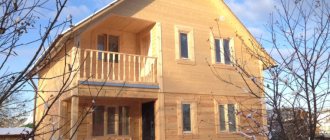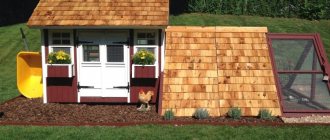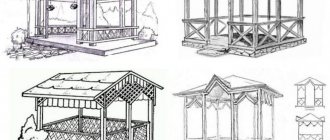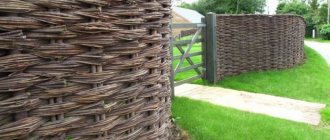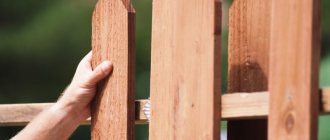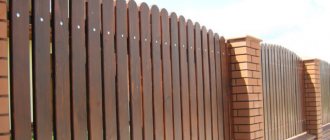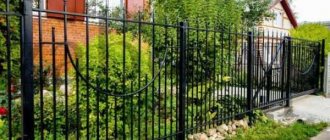SHARE ON SOCIAL NETWORKS
FacebookTwitterOkGoogle+PinterestVk
Modern decorative fencing is an integral part of decorating a suburban area. With its help, you can zone space and fence objects for security purposes. For example, installing such a structure around a lake will protect vacationers from accidentally falling into a pond. A decorative fence for a summer house performs an aesthetic function. The overall picture of the site will look harmonious if the fence is made in the same style as other objects.
Decorative hedges are used to decorate flower beds, flower beds, front gardens and other areas of the garden.
Natural materials
A homemade wattle fence made from twigs will look original. For this you will need:
- Twigs and branches
- Secateurs
- Knife
- Axe
- Scrap
- Hammer
- Roulette
Divide the rods into 2 parts. Thick branches are suitable for vertical stakes, and thin branches should be used to weave walls. From large branches you need to separate the side shoots and shorten them to the desired height.
Make a mark along which the fence will be installed. To make holes for stakes, drive a crowbar into the ground with a hammer. Carefully drive the stakes into the holes. To avoid damaging them, it is better to use a mallet rather than a hammer.
When weaving walls, start working from the bottom. One horizontally located rod should go around two vertical ones. After the walls are woven, trim off the branches protruding onto the last stake.
Functions of a decorative fence
The following are distinguished:
- Zoning. When a fence neatly separates the residential part of the estate from the recreation area or the garden from the rest of the yard.
- As limiters. Installation is carried out around the perimeter of planting weaving plants so that they do not become an obstacle to movement. Another option - in high flower beds it serves as protection against soil spillage. Separates individual types of plants.
- Accent. When the owners want to emphasize a particular part of the territory. For example, select a flowerbed in front of the entrance to the house, decorate the lawn around a small fountain.
A well-chosen fence is an element of landscape design. It becomes an addition to the architectural ensemble of the site.
Tree
You can also make a wooden fence to enclose a flower bed. The material almost always fits harmoniously into the design of the site.
It is not necessary to specifically purchase wood for this purpose - you can use the remains of wood already on the farm. Depending on the quantity, length and shape of the scraps, you can think about the appearance of the future fence.
Thick boards will make a picket fence, or you can make a stylish fence by placing these boards horizontally.
To make a picket fence, you need:
- Roulette
- Wooden posts
- Material for crossbars
- Facing board (directly the picket itself)
- Nails or screws
- Concrete
It is very easy to build such a fence - calculate the required height and length and cut the boards and posts to the required size.
To ensure that the structure lasts longer and does not sag, the holes in which they are installed should be concreted without digging the posts. Then screw the crossbars and place the pickets at an equal distance from each other.
The “transparency” of the barrier depends on the width of the step between the facing boards. You can also carve patterns on the top of the facing boards, this will add originality to the design.
A subtype of a picket fence is “checkerboard” - the boards are stacked alternately on both sides of the crossbar board. From the front, the fence looks blank and solid, but when viewed from an angle, gaps are noticeable. Such a fence looks interesting, unusual and impressive. The downside is the high consumption of material during construction.
A horizontal fence is built using approximately the same principle. In this case, crossbars are not needed, and the picket is attached horizontally to pillars spaced from each other by the length of the facing board.
New Year's crafts from pine cones: decor ideas from pine cones for the New YearDecorative elements made of stone as an integral part of landscape design
Smartphone case: overview of the main types
Thin slats can be used to create a lattice fence. This fence looks light, fresh and original.
A low fence of this type will look good around a flower bed, and a high one will give an unusual look to the gazebo. The decoration of such a net will be any climbing plant - wild grapes, ivy, clematis or annual morning glory.
Typically, picket “cells” are mounted on a square or rectangular wooden base. You can buy such blocks at a construction hypermarket, or you can sharpen such a fence with your own hands.
There are many options for the arrangement of slats in such a fence and everything is limited only by your imagination. The slats can be placed horizontally, vertically or diagonally, the distance between the slats or their width can be varied, and each time the fence will have a different appearance.
Stainless steel fences for the front garden: types of metal fencing
A decorative metal fence is an excellent modern solution for decorating a dacha or country house. This material easily withstands any environmental influences and does not corrode. In addition, it is resistant to mechanical damage. A stainless steel fence can maintain a presentable appearance for up to 50 years. It does not require processing or special care.
A metal fence allows you to create stylish compositions on your site
It is easy to create stylish decorative fences from metal for flower beds, front gardens, recreation areas, games and other objects in the local area. Rust resistance is determined by the amount of chromium that is included in the material. Steel containing up to 15% chromium works well under normal conditions. If this value exceeds 15%, the material is resistant to corrosion processes in a particularly aggressive environment and in conditions of high acidity.
There are a lot of options for assembling metal structures. Separate fragments (pickets) or ready-made spans are used. In photos of decorative fences you can often see combined fences (for example, with materials such as concrete, stone or brick). To install structures using metal elements, bolts and rivets are used. In some cases, installation will require a welding machine. The ability to install such a stylish fence with your own hands is a clear advantage of this fencing option.
A metal fence is easy to install and can last for many years with proper and regular care.
Pillars
To install fences, you can buy decorative fence posts at hardware stores. They have different sizes, colors and textures, which helps you choose posts that are harmonious in design with the sections of the future fence.
Both solid products and block models are available for sale. The material for them is brick and concrete.
Pencil fence
If you are going to assemble a fence from vertical pickets, then try transforming the components into colored pencils. They can be easily shaped into both boards and logs. It is enough to cut their upper end in the form of a cone and give it the appearance of a rod. Each element can be painted in its own color. The fence will turn out bright and colorful.
Bright decorative fence made of pencils of different heights
Concrete scenery
When you mention a concrete fence, a gloomy gray structure of gigantic height immediately appears before your eyes, depressing and overwhelming. If you think that you are being asked to build something similar on your site, you are mistaken. To decorate lawns and paths you will need bright elements with beautiful patterns on the outside.
Decoration for a concrete fence
Concrete parts for a cheerful fence can be cast with your own hands. For this you will need polyurethane or plastic molds. They are lubricated with vegetable oil (this is necessary so that the finished product does not stick to the mold) and filled with a concrete mixture solution. It should have the consistency of thick sour cream, so when adding water to the cement-sand mix, take this into account.
There are a large number of concrete casting molds on the market.
In the traditional recipe, 2 portions of sand are added to a portion of M 250 cement. Remember that too much sand will make the section darker. The holding time of the solution in the mold is 24 hours. After hardening, the finished element is removed. Having collected the required number of sections, you can begin installing the fence. You can paint the finished fence with pictures or simply paint the sections with different colors.
Decorative concrete fencing followed by painting


